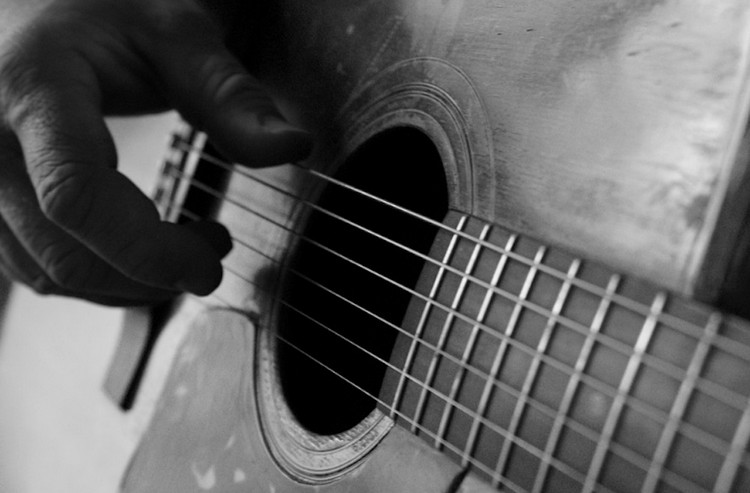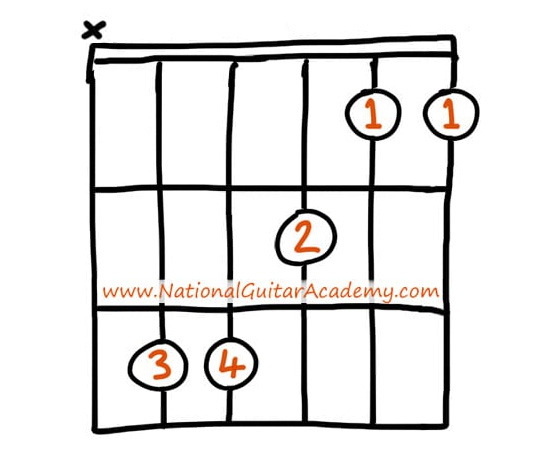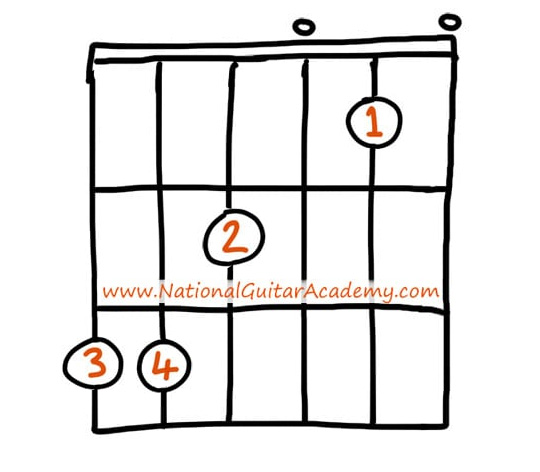Roll up your sleeves and get ready to strum like Johnny Cash, today we’re going to teach you alternating bass strumming techniques for guitar!
Over 100,000 guitar-learners get our world-class guitar tips & tutorials sent straight to their inbox: Click here to join them
In this free lesson you will learn…
- What alternate bass strumming is
- How to use it with chords you already know
- Why this technique is as awesome as it is easy!
- Some amazing musicians who commonly use this technique
Alternating Bass Strumming: Learn To Boom-Chuck Like Johnny Cash!
If you’re learning to play guitar and you’ve gravitated toward folk or country music, this lesson is for you!
There is a particular rhythm pattern that happens all the time in folk, bluegrass, roots, country, and western music, and even some jazz. You’ll need to know it in order to get the feel right in any of these styles.
- We call this alternating bass strumming because you’re going to alternate the chords with different bass notes.
- Luckily, it’s not terribly complicated, and it’s fun to practice.
- This is going to give your guitar a lot more width in its sound, so get ready to level up your playing!
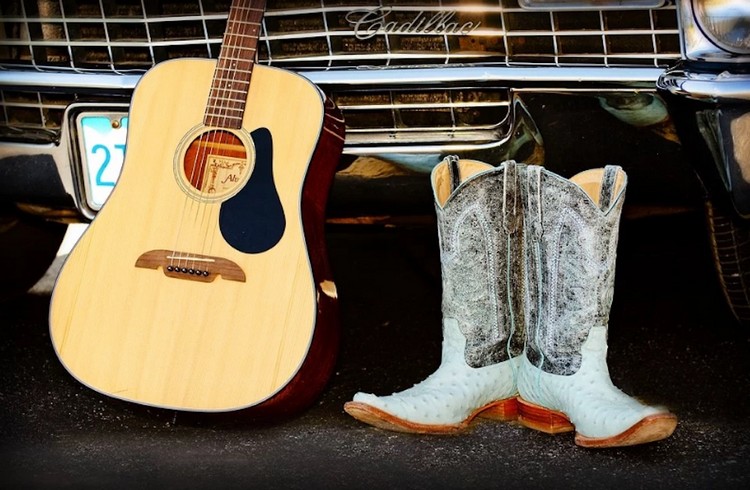
In this lesson, we’re going to learn which notes to pick with which chords and why, what rhythm to use, and how to practice.
It takes some time to develop the ability to consistently hit the right strings, but we’ve got a few tips for you to help you get there as quickly as possible.
By the end of this lesson, you’re going to have an amazing and versatile new technical skill on the guitar, so let’s get to it!
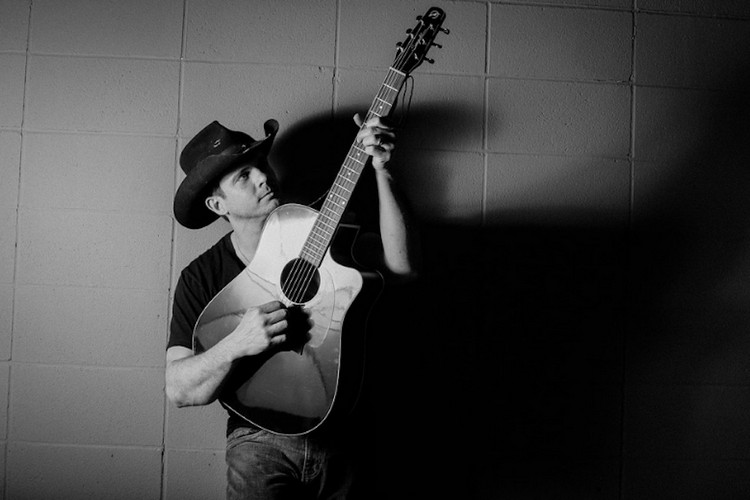
Alternating Bass Strumming: The Rhythm
At the basic mechanical level, alternating bass strumming is there to add a bass sound to your solo guitar arrangements.
The bass has two jobs – one rhythmic; the other harmonic.
- In most styles of music, the bass’s rhythmic function is simply to keep track of the beat.
- The bass player can do this by playing on the beat, or even just on every other beat.
- The bass’s job in terms of harmony is to reinforce whatever chord is happening in any given moment, commonly by playing the root or leading the ear to the root of the chord.
- In solo guitar arrangements, the guitar can take over the job of the bass by doing these two things.
In terms of rhythm, you would pick a string on the first and third beats of the measure, like this:
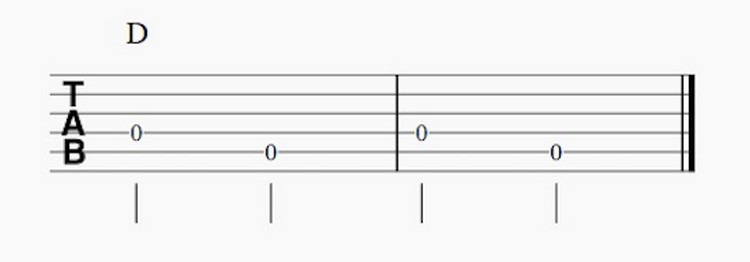
What’s a measure? What is that supposed to be?
If you’re not sure about that, bookmark this guide and take a pit stop at Reading Guitar Music: The Ultimate Guide.
Notice that for the D chord in the figure above, the guitar plays the open D string on beat one and the open A string on beat three.
- If you try that, you’ll hear your guitar doing the job of the bass.
- This gives us the “boom” part of the strum.
- The “chuck” part of alternating bass strumming happens on beats two and four.
Whatever chord you’re on – in this case, D major – strum it in between those bass notes.
That will look like this:
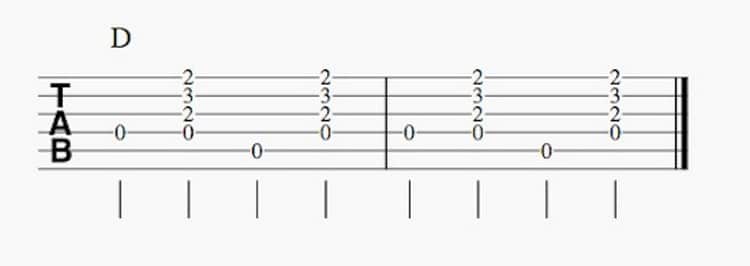
Learn 12 EASY beginner chords with our popular guide

✅ Stop struggling. Start making music.
✅ Learn beginner-friendly versions of every chord.
This is our most popular guide and it will improve your chord ability quickly! 😎
Get your own personalised guitar-learning plan 🎸
Get a custom guitar-learning plan here: Click here for GuitarMetrics™
World-Class Guitar Courses 🌎
Learn from the world's best guitar educators: Click here for our guitar courses
Alternating Bass Strumming: Technique
As you can see for the D major chord, you’re picking the D string on beat one and the A string on beat three, strumming the D chord on two and four.
Before we even get any further into this lesson, we’re going to practice that D chord with alternating bass strumming.
Pro Tip: Avoid looking at the strings.
- We just don’t have time to check with our eyes to make sure that we’re hitting the correct strings when we start to pick up the pace.
- What this means is that you’re going to be pretty inconsistent at hitting the correct strings until you teach your strumming hand where they are without looking.

Here are some time-tested helpful hints to help you get consistent at hitting the correct strings in the shortest possible time:
Small-Range Hand Motion Picking Exercise
Practice hitting the D string by pushing your pick down past the D string and letting your pick come to rest on top of the G string. Do this over and over until you’re very sick of doing it.
Your pick should be moving down toward the floor, parallel to the string.
Avoid “scooping” to try to make a louder sound.
Scooping just makes your string slap back against the fretboard, which is a pleasing sound when employed tastefully on the bass but just sounds too spanky on the guitar.
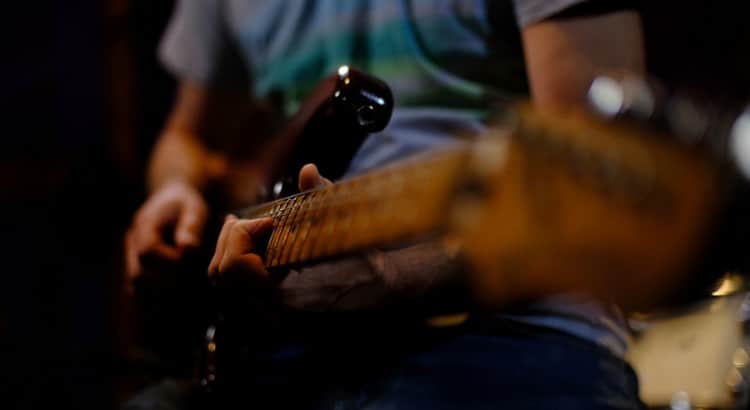
Although we usually propel our strumming motion from the wrist to get good strumming tone; when you pick a single string, you’re really only using your finger and thumb to move the pick.
- Keeping the motion small will help your hand to learn where the string is.
- Do this repetitive single string exercise on the D, A, and E strings to really work it out.
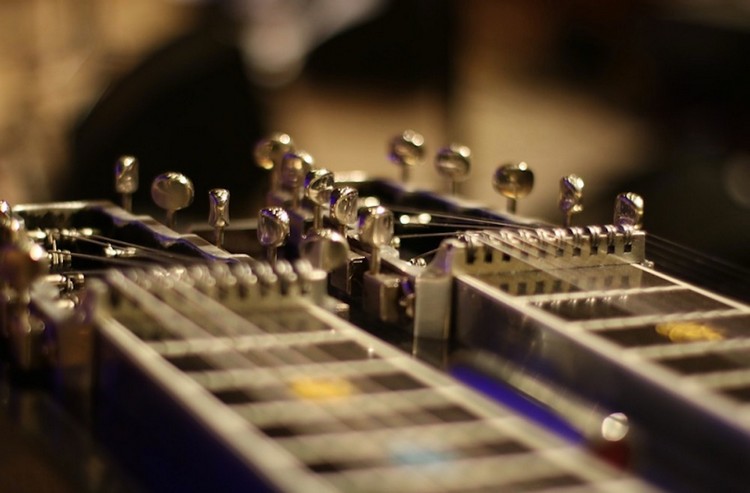
Small-Range Hand Motion Exercise On The D Major Chord
To get consistent with alternating bass strumming on a single chord, it takes quite a bit of practice.
D major is particularly tricky because the D string is smack in the middle of the guitar.
- Practice alternating bass strumming on the D major chord with the small hand motion that we’ve just gone over.
- Play this one chord until you’re sick of it.

With the strum, it does not matter whether or not you hit the D string. You want to make sure that you’re emphasizing the higher-sounding strings where the chord shape is.
Use a small wrist motion to strum the chord. This will get your hand back to where it needs to be more efficiently.
The interplay between bass and treble notes is what makes your guitar sound like two different instruments! Practice makes perfect!

Pro-Tip: We can’t emphasize enough how important a small hand motion is in alternating bass strumming.
- Keep your fingers close to the string they have to find. And be patient with yourself!
- Developing consistency in this kind of surgical guitar work just takes time and repetition.
- You’ll get there!

Alternating Bass Strumming: The Theory
How many bass players does it take to change a light bulb?
One… five… one… five!
This music theory joke may not be very funny, but if you don’t understand it, you’re about to!
The picking part of alternating bass strumming involves two of the three notes in a basic major or minor chord: the root, or one, and the fifth, or five.
The root is the note after which the chord is named, and the fifth is the stabilizer note.
The other note in a chord, the third, is the note that tells you whether the chord is major or minor.
Pro Tip: The root and fifth are the same in major and minor chords.
In D major, the notes are D (root), F# (third), and A (fifth). In D minor, the notes are D (root), F (third), and A (fifth).
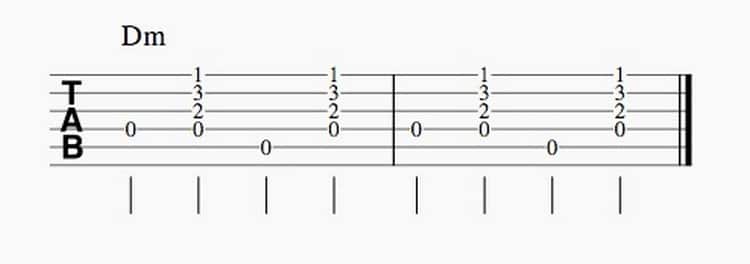
As you can see above, the alternating bass strumming pattern for the D minor chord is the same as it is for the D major chord.
- As a matter of fact, that same alternating bass strumming pattern works for all open position D chords: major, minor, major seventh, seventh, minor seventh, sus2, and sus4.
- It does not work for D augmented or diminished because in those chords, the fifth is altered!
To find the alternating bass notes for any chord, count up from the root in first position. When you get to the fifth position, you’ve found your alternating bass note.
- There are flats and sharps, but you don’t have to worry about them too much.
- The only time the musical alphabet counting trick doesn’t work is for B and Bb chords, which are commonly played as barre chords.

Alternating Bass Strumming: The Chords
As you develop your chord vocabulary on the guitar, you can start to become familiar with where the chord tones are on each shape.
This is really useful because you can move those chord shapes up the neck and the placement of the chord tones stays constant.
It’s important to be able to locate the chord tones in a shape (particularly the root and fifth), because those are the notes you’re hitting on beats one and three.

D, A, & E: Next String Over
For all open chords named D, A, and E – that includes the major, minor, seventh, and suspended – the alternating bass strumming pattern is simple.
As we’ve seen for D, the root is D and the fifth is A.
Our pattern then is D string, strum, A string, strum.
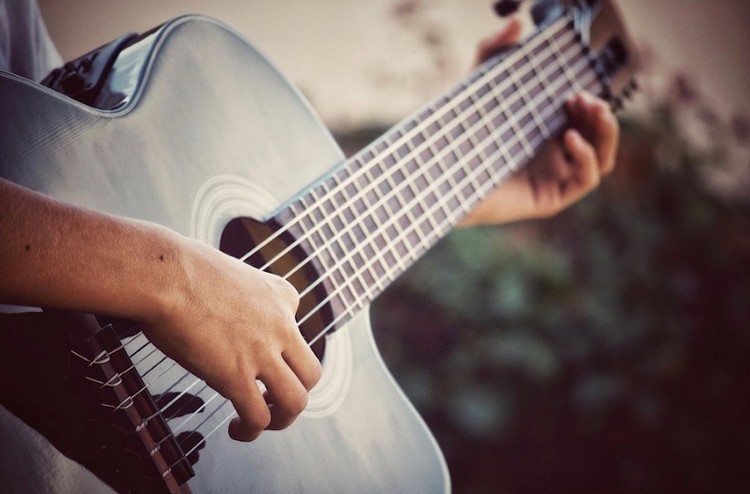
For A, the root is A and the fifth is E.
Our pattern then is A string, strum, low E string, strum.
There are other Es in the chord, but you want to find the lowest one to emulate the bass.
For E, the root is E and the fifth is B.
When you make open E chord shapes, the A string is always fretted at the second fret.
This makes the note on the A string a B.
Our pattern then is low E string, strum, A string, strum.
Keep holding the chord shape as you pick the individual strings.

F, C, & B7: One String Over, Modified Shape
For the four-string F chord, the root is F and the fifth is C.
The lowest C on the guitar is the A string third fret, so you have two options, shown below.
You can either move your ring finger back and forth between the D and A strings, like this:
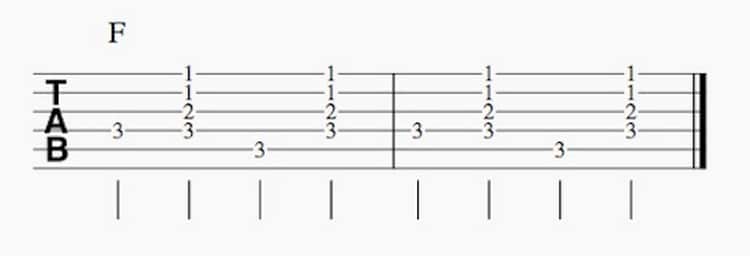
Alternatively, you can set up your F chord in the first place to permanently fret the A string at the third fret. Fingerstyle folk players sometimes favor this chord shape.
F (x33211)
(If you don't understand the above image please read our article "How To Read Guitar Chordboxes In 60 Seconds". It will make everything clear!)
The same basic principle is true for the C chord.
The root is C, and the fifth is G, which lives on the low E string at the third fret.
You can either move your ring finger back and forth between the A string and E string, or you can set up your C chord like this.
C (332010)
For the B7 chord, the root is B at the A string second fret.
The fifth is F#, on the E string at the second fret.
Since the open B7 chord occupies all four of your fingers, the only option is to move your middle finger back and forth between the A and E strings, like this:
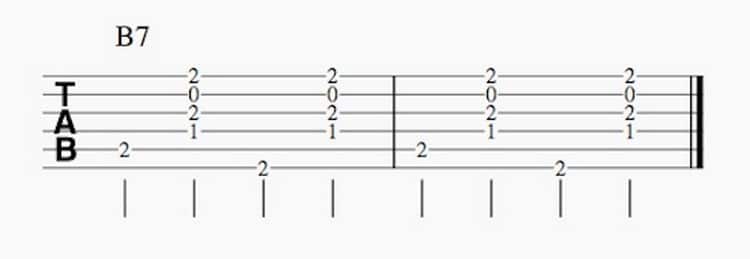
G: The Only One That’s Like This
The G chord has G as its root on the E string, third fret.
The fifth is the open D string.
- The alternating bass strumming pattern for the G chord is E string third fret, strum, D string, strum.
- This one takes a little more practice because you have to skip over the A string.
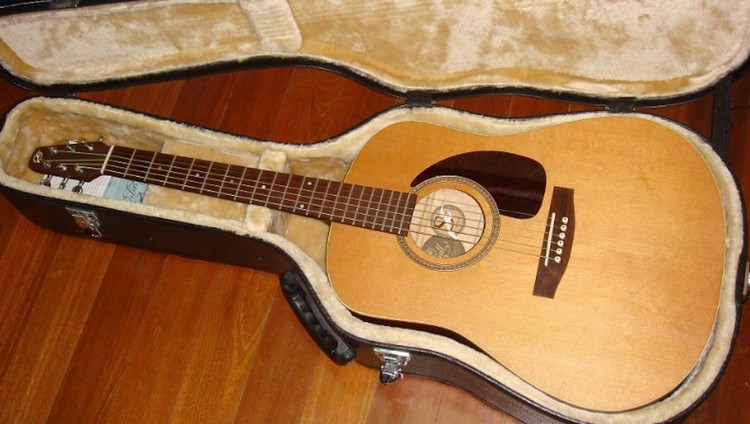
Pro-Tip: Interested in learning more about notes and how to find them on the guitar?
Check out this lesson: Notes on a Guitar: Unlocking the Fretboard
Download our lead guitar cheat-sheet to make things easier
It's hard to understand which scales work with which keys.
So we created a cheat-sheet! A key and scale-finder that you can use again and again.

Get your personalised guitar-learning plan 🎸
Get a custom guitar-learning plan here: Click here for GuitarMetrics™
World-Class Guitar Courses 🌎
Learn from the world's best guitar educators: Click here for our guitar courses
Barre Chords: Easier Than You Think!
If you’re wondering how to layer alternating bass strumming on top of the already strenuous work of making barre chords, don’t stress.
Most of the barre chords we use in everyday guitar life are either E shapes or A shapes.
Remember: the barring finger is just like a moveable capo, and we’re using our other three fingers to make some sort of E shape or A shape on top of it.
With that, for any E-shaped barre chord, the alternating bass strumming will work just like the open E chord shape.
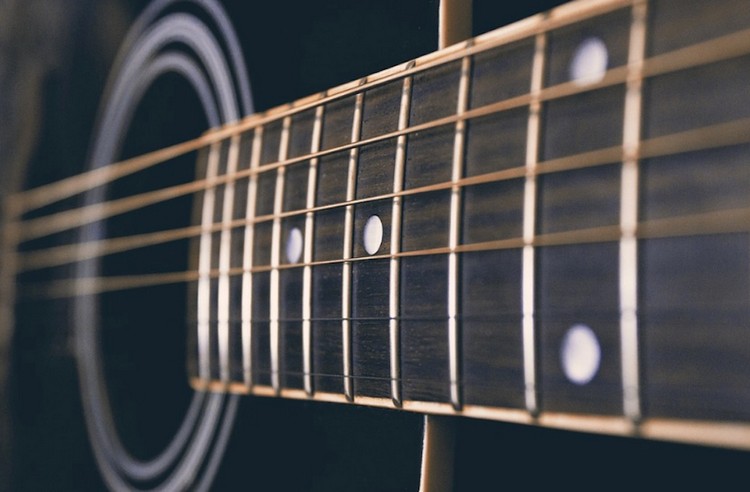
You’ll pick the E string, strum the chord, pick the A string, and strum the chord again, all while holding the barre chord shape.
For the A-shaped barre chords, the alternating bass strumming will work just like the open A chord shape:
A string, strum, E string, strum.
Make sure you’re fretting the low E string with your barring finger when you’re performing alternating bass strumming with the A-shaped barre chords so the correct note plays.
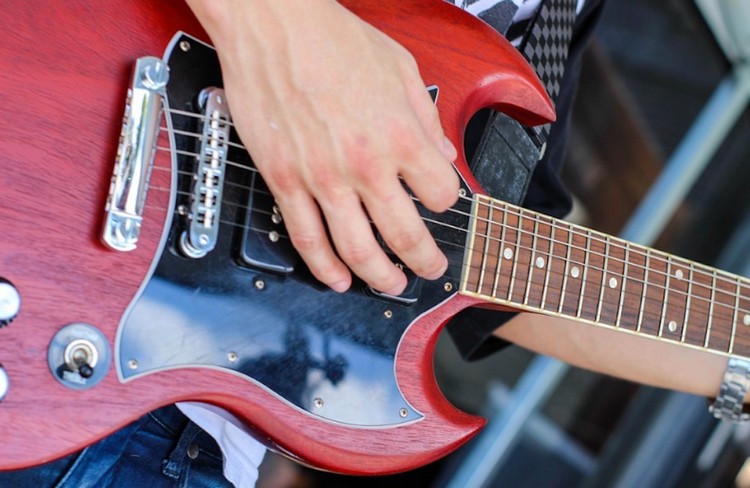
Alternating Bass Strumming: 3/4 Time
Occasionally, we run into songs that we’d like to play with alternating bass strumming, but there’s one problem: they’re in 3/4 time.
That means each measure has three beats instead of four, and we can’t fit the alternating pattern into three beats.
In that case, all you need to do is stretch the alternating bass strumming pattern over two measures, if the chord lasts for two measures.
The pattern looks like this:

Alternating Bass Strumming: Song Examples
You can use alternating bass strumming wherever you want in any song you choose, but here are a few of our favorites that you can try:
Bob Seger, “Shame On the Moon”
Don Williams, “I Believe In You”
Willie Nelson, “Blue Eyes Crying In the Rain”
Johnny Cash, “Down In the Valley”
Osborne Brothers, “Rocky Top”
Waylon Jennings, “Mamas Don’t Let Your Babies Grow Up to Be Cowboys”

Take the Time to Learn This Essential Guitar Skill!
Even if you’re not particularly interested in country, bluegrass, or folk music, learning alternating bass strumming benefits your playing.
You’ll become more precise in your picking, tighten up your rhythm skills, and gain fluidity in your chord changes. Keep practicing and keep jamming!
Recommended Resources
If you enjoyed this free guide from the National Guitar Academy, you’ll love our other free content below!
What Type of Guitarist Are You?
Take our 60-second quiz & get your results: Take The Quiz
Join the world's best online guitar school 🌎
- Get your own personalised guitar learning plan (customised just for YOU).
- World-class online guitar courses. Learn at your own pace.
- Community Campus & Learning Forum - A friendly community! Connect with our team & students. 😊
- Beginner Song library with chordsheets, tabs and tips. (Songs suitable for all levels!)
- Regular live streams, seminars and Q&A sessions - Learn from world-class guitar educators. Get all your questions answered!
Click here to learn more about National Guitar Academy membership 
Cool Guitar T-shirts 😎
Look cooler! Check out our merch: Click here to see our merch store
Want free guitar tips and video lessons delivered to your inbox?
Join over 100,000 guitar-learners and subscribe to our guitar-tips-by-email service. (It's free.)
We'll send you a series of lessons that will move you to the next level of your guitar journey.
Learn how everything fits together quickly, easily and effectively. We share ninja tips (for instant fun!) but also timeless fundamentals that will deepen your understanding.

Popular Lessons
How To Learn Guitar: An 11-Step Programme For Beginners
How To Choose The Perfect Beginner Guitar
More Cool Guitar Stuff
Learn about National Guitar Academy: About Us
Join us on Facebook for daily guitar tips.
Listen to our Learn Guitar Podcast for rapid guitar progress.
Check out our free chord lessons.
Get our best guitar tips & videos
Where should we send it?
Where should we send it?
Get our best guitar tips & videos

